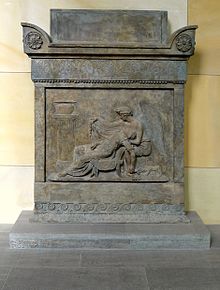Julie von Voss
Julie Amalie Elisabeth von Voss, Countess von Ingenheim (born July 24, 1766 in Buch near Berlin ; † March 25, 1789 Berlin) was court lady and later wife of the Prussian King Friedrich Wilhelm II.
Life
Julie was the daughter of Friedrich Christoph Hieronymus von Voss and his wife Amaliea Ottilie von Vieregg (* December 17, 1736, † October 30, 1767 in Berlin). Theodor Fontane reports that in the church book her name is said to have been entered as Elisabeth Amalie von Voss at birth and death . Her siblings were Otto Carl Friedrich , Albrecht Leopold (* 1759 - May 31, 1793) and Ferdinand Georg Wilhelm Ernst von Voss.
In 1783 she became - like her aunt Sophie , who later became Queen Luise's chief stewardess - lady- in- waiting to Queen Elisabeth Christine . There she met the heir to the throne, Friedrich Wilhelm .
The prince, who had meanwhile become king, had received written consent to the morganatic marriage from his wife, Queen Friederike Luise , who, after seven births, considered her marital duties fulfilled. The "second marriage" was signed on April 7, 1787 in the Charlottenburg Palace Chapel . In November 1787 Friedrich Wilhelm II raised Julie von Voss to Countess von Ingenheim.
Only two years later, on March 25, 1789, at the age of 22, she succumbed to galloping consumption ( pulmonary tuberculosis ), which broke out immediately after the birth of her son Gustav Adolf (1789–1855).
Theodor Fontane has dedicated a separate chapter to the fate of Julie von Voss in the volume Spreeland of his walks through the Mark Brandenburg . When he visited Berlin-Buch on June 16 and 17, 1860 with his publisher, Wilhelm Hertz, he recorded sketches and information in his notebook.

On April 1, she was buried in the castle church of Buch in a crypt near the altar, which, according to Theodor Fontane, happened at her own request. In his notebook he sketched the floor plan on which the "Crypt of Ingenheim" is drawn. However, later investigations found neither grave nor bones at this point. In 1795, Julie's brother had an epitaph built by Hans-Christian Genelli in Buch's castle park , on which only the inscription “Soror optima, amica patriae, vale” (“Best sister, friend of the fatherland, farewell”) is written. The tomb was willfully destroyed in the 1950s. Only the relief was saved and exhibited in the Schinkel Museum, which opened in 1987 in the Friedrichswerder Church. In 2019, the location of the tomb was found in the northern part of the castle park.
Theodor Fontane has given in detail the correspondence with her aunt over the years. Annemarie von Nathusius set her in 1918 with the novel The foolish heart of Julie von Voss. A court story from the Zopfzeit a literary monument.
literature
- Theodor Fontane : Walks through the Mark Brandenburg . Volume 4 ( Spreeland ) "Right of the Spree" - Book: Julie von Voß
- Theodor Fontane: Wondrous Women. Female life pictures from the "" Walks through the Mark Brandenburg ". Ed. By Gabriele Radecke and Robert Rauh . Manesse, Munich 2019, ISBN 978-3-7175-2500-4 . The king's mistress: Julie von Voss
- Gothaisches genealogical pocket book of noble houses 1903. Fourth year, p. 876.
- Genealogical paperback of the German count's houses. 1842, pp. 257f. Ingenheim
Individual evidence
- ^ Theodor Fontane: Notebooks. Digital genetic-critical edition. Edited by Gabriele Radecke . Göttingen 2015 ff. Notebook A11, sheet 3r ff.
- ^ Gabriele Radecke and Robert Rauh: Theodor Fontane and the tragic fate of Julie von Voss. In: Berliner Zeitung, December 8, 2019
| personal data | |
|---|---|
| SURNAME | Voss, Julie von |
| ALTERNATIVE NAMES | Julie von Voss, Countess of Ingenheim |
| BRIEF DESCRIPTION | morganatic wife of King Friedrich Wilhelm II of Prussia |
| DATE OF BIRTH | 4th July 1766 |
| PLACE OF BIRTH | Book near Berlin |
| DATE OF DEATH | March 25, 1789 |
| Place of death | Book near Berlin |
